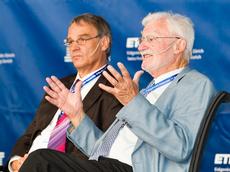Nobel Prize-winning physicists dies at 79
Swiss physicist and ETH-Zurich alumnus Heinrich Rohrer died May 16 at his home in Wollerau, Switzerland. He is most known for his collaborative work with Gerd Binnig in developing the scanning tunnelling microscope, for which they both received the Nobel Prize in 1986.

Rohrer studied physics at ETH Zurich from 1951 to 1955 – more by chance than anything else, as he often said. His professors included Wolfgang Pauli and Paul Scherrer. In 1960 Rohrer completed a doctorate at ETH Zurich with a project on length variations in superconductors. After a stint as an assistant, he transferred to Rutgers University (USA) in 1961 to do a postdoc on superconductivity. Two years later the thirty-year-old returned to Switzerland, joining the IBM research laboratory in Rüschlikon.
At IBM, between 1979 and 1981, he succeeded in creating the scanning tunnelling microscope with Gerd Binnig. This non-optic instrument revolutionised microscopy and was important for the targeted manipulation and modification of individual molecules and nanostructures and their application in physics, electronics, chemistry, biology and medicine. Rohrer and Binnig subsequently received numerous high honours and accolades, including the Nobel Prize for Physics in 1986, which they shared with Ernst Ruska. Rohrer obtained various other awards for his research and honorary doctorates from numerous universities in Europe, the USA and Asia. In the course of his career, he also climbed the ladder at IBM: he became Chairman of the IBM Department of Physics and was made an IBM Fellow after his Nobel Prize.
Father of nanotechnology
Although Rohrer retired in 1997, he remained scientifically active and took on various research assignments all over the world. In his later work, he focussed on nanotechnology, playing a major role in developing the invention of the scanning tunnelling microscope. Two years ago, Heinrich Rohrer was a guest of honour when IBM and ETH Zurich opened their joint Binnig and Rohrer Nanotechnology Centre, which was named after the two “fathers of nanotechnology” (cf. ETH Life report from 18.05.2011).
Heinrich Rohrer passed away last week after a long illness, as his family announced at the weekend.







READER COMMENTS